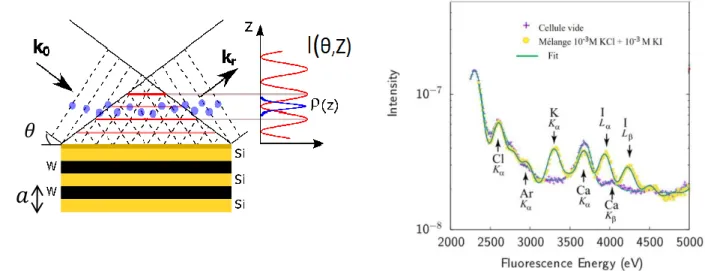HAL Id: cea-02341903
https://hal-cea.archives-ouvertes.fr/cea-02341903
Submitted on 31 Oct 2019
HAL is a multi-disciplinary open access
archive for the deposit and dissemination of
sci-entific research documents, whether they are
pub-lished or not. The documents may come from
teaching and research institutions in France or
abroad, or from public or private research centers.
L’archive ouverte pluridisciplinaire HAL, est
destinée au dépôt et à la diffusion de documents
scientifiques de niveau recherche, publiés ou non,
émanant des établissements d’enseignement et de
recherche français ou étrangers, des laboratoires
publics ou privés.
Ions at interfaces: accessing the first nanometers using
X-ray standing waves
Soumaya Ben-Jabrallah, Florent Malloggi, Luc Belloni, Luc Girard, Dmitri
Novikov, Cristian Mocuta, Dominique Thiaudière, Jean Daillant,
To cite this version:
Soumaya Ben-Jabrallah, Florent Malloggi, Luc Belloni, Luc Girard, Dmitri Novikov, et al.. Ions at
interfaces: accessing the first nanometers using X-ray standing waves. Flow17, Jul 2017, Paris, France.
�cea-02341903�
Flow17 Conference France, Paris, 3-5 July 2017
Topic No. 4
Poster
Ions at interfaces: accessing the first nanometers using X-ray standing waves
Soumaya ben Jabrallah,1 Florent Malloggi,1 Luc Belloni, 1 Luc Girard,2, Dmitri Novikov,3Cristian Mocuta,4 Dominique Thiaudière, 4 and Jean Daillant 4
1 LIONS-NIMBE, CEA, CNRS, Université Paris-Saclay, CEA Saclay, Gif sur Yvette, France 2 ICSM UMR 5257 - CEA / CNRS / UM / ENSCM, Site de Marcoule, Bâtiment 426
BP 17171 F-30207 Bagnols sur Cèze Cedex
3 Deutsches Elektronensynchrotron DESY, Notkestrasse 85, D-22607 Hamburg, Germany
4 Synchrotron SOLEIL, L’Orme des Merisiers, Saint-Aubin, BP 48, F-91192 Gif-sur-Yvette Cedex, France
Keywords: X-ray standing waves, X-ray fluorescence, diffuse layer,
Ion-surface interactions are of high practical importance in a wide range of technological, environmental and biological problems [1-4]. In particular, they ultimately control the electric double layer structure, hence the interaction between particles in aqueous solutions. Despite numerous achievements, progress in their understanding is still limited by the lack of experimental determination of the surface composition with appropriate resolution.
In the present work, we have developed a method based on X-ray standing waves coupled to nano-confinment which allows the determination of ion concentrations at a solid-solution interface with a sub-nm resolution.
We have investigated mixtures of KCl/CsCl and KCl/KI in 0.1mM to 10mM concentrations on silica surfaces and obtained quantitative information on the partition of ions between bulk and Stern layer as well as their distribution in the Stern layer [5]. Regarding partition of potassium ions, our results are in agreement with a recent AFM study [6]. We show that in a mixture of KCl and KI, chloride ions exhibit a higher surface propensity than iodide ions, having a higher concentration within the Stern layer and being on average closer to the surface by ~ 1-2 Å, in contrast to the solution water interface. Confronting such data with molecular simulations will lead to a precise understanding of ionic distributions at aqueous interfaces.
Figure 1. Left. Schematics of the standing wave experiment. Incident (wave vector kin) and reflected (wave vector kr) X-ray waves interfere
to create a standing wave field perpendicular to the interface. The species (sketched by blue dots) present in the XSW field are excited and emit secondary fluorescence photons for absorption edges below the incident beam energy. Right. Fluorescence intensity (experiments: symbols - fits:solid lines) recorded at 1.95° from an empty cell and a 250nm thick cell filled with a 10mM KCl + 10mM KI solution.
[1] J. Lyklema, Fundamentals of Interface and Colloid Science Volume 2, Solid-Liquid Interfaces, Academic Press, (1995). [2] M. Cacace, E. Landau and J. Ramsden, Quarterly Reviews of Biophysics, 30, 241–277 (1997).
[3] W. Kunz Ed., Specific Ion effects, World Scientific, Singapore, (2009). [4] P. Jungwirth and D. Tobias, Chemical Reviews, 106, 1259–1281 (2006). [5] ben Jabrallah, S. et al. Phys. Chem. Chem. Phys., 19, 167-174 (2017).
[6] C. Zhao, D. Ebeling, I. Siretanu, D. van der Ende and F. Mugele, Nanoscale, 7, 16298-16311 (2015).
